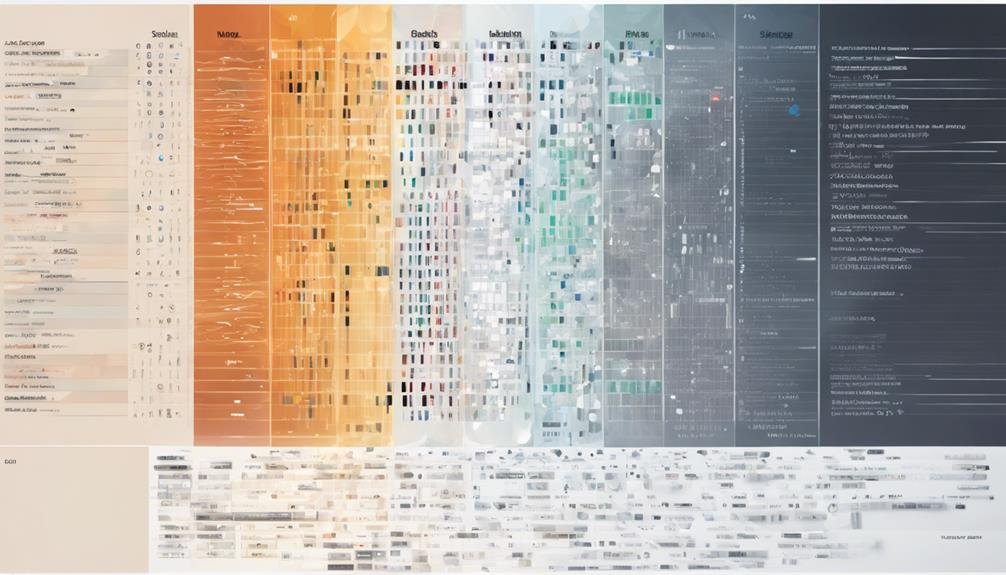Solidity, the cornerstone of DApp development, is a transformative programming language for crafting smart contracts on platforms like Ethereum. Introduced by Gavin Wood in 2014, it shapes the logic and security of decentralized applications, ushering in an era of automated and secure transactions. It guarantees robust contract creation with features like state variables, Booleans, and modifiers. Solidity’s support for various data types and execution modes enhances contract performance, fostering the development of custom tokens, efficient data management, and scalability in blockchain applications. Understanding Solidity is not just fundamental, it’s enlightening, as it reveals a wealth of tools and techniques for building robust decentralized solutions.
Table of Contents
Brief Overview of Ethereum DApp Development With Solidity
- Solidity is a programming language for creating smart contracts in decentralized applications (DApps).
- It ensures secure and automated transactions within the Ethereum ecosystem.
- Solidity supports various data types, inheritance, and libraries for scalable blockchain applications.
- Custom tokens and digital asset management are efficiently achieved through Solidity.
- Solidity enhances DApp functionality, security, and robustness in decentralized ecosystems.
Evolution of Solidity
Since Gavin Wood’s proposal in August 2014, Solidity has come a long way. It has evolved into a pivotal language for smart contract development on platforms like Ethereum and Hyperledger Burrow. As a programming language specifically designed for writing smart contracts on the blockchain, Solidity has played a vital role in developing decentralized applications (DApps). Its syntax, influenced by languages like JavaScript, Python, and C++, enables developers to define data types, functions, and logic for executing transactions securely on the Ethereum blockchain.
Since its initial release in August 2015, Solidity has seen regular updates and improvements, reflecting the growing needs of the blockchain community. Its integration with Ethereum Virtual Machine (EVM) allows for the execution of smart contracts, making it a versatile tool for building decentralized applications. Solidity’s adaptability and compatibility with various blockchain platforms make it essential in blockchain development, empowering programmers to create innovative solutions for the decentralized future.
Ethereum Virtual Machine (EVM)

The Ethereum Virtual Machine (EVM) is a decentralized runtime environment pivotal for executing smart contracts on the Ethereum blockchain. An essential aspect of EVM is its functionality overview, which guarantees the secure and reliable execution of smart contract code. Understanding the EVM gas limit is also critical, as it dictates the computational resources required to process Ethereum network transactions.
EVM Functionality Overview
Executing smart contracts on the Ethereum blockchain is facilitated by the Ethereum Virtual Machine (EVM). This runtime environment guarantees secure and reliable code execution by all network nodes. The EVM is designed to prevent Denial-of-Service attacks and offers a trusted execution environment for decentralized applications. Smart contracts, typically written in languages like Solidity, are compiled into bytecode that the EVM processes.
This decentralized, Turing-complete virtual machine ensures deterministic outcomes, which is essential for maintaining consistency across the network. By providing secure execution and enforcing rules for smart contract interactions, the EVM plays a pivotal role in the Ethereum ecosystem. Its ability to execute code trustworthy and impartially forms the backbone of Ethereum’s smart contract functionality.
EVM Gas Limit
When developing decentralized applications on the Ethereum blockchain, understanding and adhering to the EVM gas limit is essential to ensure efficient transaction processing and prevent resource abuse. The EVM gas limit represents the maximum allowable gas consumed during a transaction or smart contract execution. Gas is crucial as it covers the computational work on the Ethereum network, with each operation requiring a specific amount.
If the gas limit is exceeded, transactions or contract executions are reversed to avoid infinite loops and resource depletion. Miners adjust the gas limit based on network conditions to maintain efficiency. Developers must optimize their smart contracts to operate within the EVM gas limit for successful execution on the Ethereum blockchain.
Solidity Data Types

Solidity presents a variety of essential data types for managing information within smart contracts efficiently. These data types include bool for Boolean values, uint for unsigned integers, int for signed integers, address for Ethereum addresses, string for textual data, bytes for raw binary data, and arrays for storing collections of elements. Vital data types in Solidity facilitate logical operations within smart contracts, as they return ‘1 for true and ‘0 for false.
Whether single or multidimensional, arrays are used to store and access data effectively. Solidity’s data types significantly define variables, parameters, and storage structures within smart contracts on the Ethereum blockchain. By utilizing these data types effectively, developers can manage and manipulate data securely and efficiently in their decentralized applications. Understanding these data types is fundamental for anyone venturing into smart contract development using Solidity.
Solidity Programming Basics

Moving from understanding Solidity data types, a foundational grasp of Solidity programming basics is vital for effectively developing smart contracts on the Ethereum blockchain. Solidity, tailored for Ethereum smart contracts, offers various features like state variables, which store contract data, and data types like Booleans and Arrays for managing information within contracts. Additionally, Solidity introduces modifiers, enabling developers to impose conditions on functions and mappings and facilitating key-value data storage.
These elements are essential in creating sophisticated Solidity smart contracts that govern decentralized applications (DApps) on the blockchain. By comprehending Solidity basics, developers can construct DApps with custom functionalities, defining the logic and behavior of their decentralized applications. Mastery of Solidity programming languages is necessary for ensuring the seamless execution of smart contracts, enabling secure and automated transactions within the Ethereum ecosystem. Accordingly, a sound understanding of Solidity fundamentals is essential for successful DApp development in blockchain technology.
Solidity Execution Modes

Understanding the two execution modes Solidity supports is essential for efficiently developing and deploying smart contracts on the Ethereum blockchain. Solidity offers bytecode for deployment on the Ethereum blockchain and opcode for execution on the Ethereum Virtual Machine (EVM). Bytecode represents the compiled form of Solidity code deployed to the blockchain for smart contract execution.
On the other hand, opcode is the low-level machine language understood by the EVM to execute operations specified in the smart contract. During deployment, Solidity bytecode transforms into EVM opcode to enable smart contract functionality on the Ethereum network. It is vital to grasp both bytecode and opcode execution modes to guarantee the development and deployment of efficient and secure smart contracts using Solidity. This knowledge enhances the ability to write robust contracts that operate effectively within the Ethereum ecosystem, emphasizing security and optimized performance.
Advantages of Solidity

Building on the foundation of Solidity‘s bytecode and opcode execution modes, exploring the advantages of this programming language reveals its significant impact on smart contract development within the Ethereum ecosystem. Solidity offers high security and reliability, which are essential for handling sensitive transactions in smart contracts. Developers benefit from the language’s compatibility with the Ethereum Virtual Machine (EVM), ensuring seamless execution of smart contracts on the blockchain.
Additionally, Solidity enables the creation of custom tokens and efficient management of digital assets, enhancing the versatility of smart contracts. The language supports various data types, allowing developers to create state variables and implement complex logic in their contracts. Furthermore, Solidity supports inheritance, libraries, and data structures, enhancing code reusability and scalability. These features make Solidity the primary programming language for creating industrial-strength blockchain applications with transparent and immutable features, further solidifying its position as a top choice for smart contract development in the decentralized ecosystem.
Solidity Development Tips

For best success in Solidity development, the following essential tips can significantly improve the efficiency and security of smart contract creation. As a programming language for Ethereum smart contracts, Solidity offers various data types such as integers, strings, arrays, and mappings, enabling developers to build intricate decentralized applications (dApps). When writing Solidity code, it is vital to contemplate the Ethereum Virtual Machine (EVM) where the code will be executed, ensuring the reliability and security of smart contract operations. Utilizing tools like Remix IDE, Truffle, and Hardhat can streamline the process of writing, testing, and deploying Solidity smart contracts efficiently.
Developers should pay close attention to Solidity’s syntax, data structures, and functions to create custom tokens, manage digital assets, and execute secure transactions on the blockchain effectively. By adhering to best practices in Solidity development, developers can enhance the functionality and robustness of their dApps, contributing to a more secure and efficient decentralized ecosystem.
Frequently Asked Questions
What Is Solidity Dapps?
Solidity DApps leverage the Ethereum platform to revolutionize DApp development by utilizing smart contracts for secure transactions. Solidity’s syntax facilitates token creation, contract deployment, and code security, enabling the creation of decentralized applications with enhanced transparency and user control.
What Is Solidity in Blockchain?
Solidity, a programming language used in blockchain, powers smart contracts on the Ethereum platform, facilitating secure contract execution for decentralized applications. Its code security is crucial for decentralized finance, token creation, and digital assets.
What Language Is Used in Dapp?
DApp programming utilizes Ethereum smart contracts, Web3 development, and token standards. Solidity syntax guarantees smart contract security in decentralized applications. It is an essential language in blockchain development, enabling contract execution and enhancing transparency.
What Is the Point of Solidity?
Smart contracts in Solidity play an essential role in Ethereum’s ecosystem by enabling secure, decentralized applications. They execute code on the blockchain, facilitating cryptocurrency transactions, managing digital assets, and automating contracts with robust security measures.
Conclusion
To sum up, Solidity is an essential programming language for developing decentralized applications on the Ethereum blockchain. It has become a powerful tool for creating smart contracts due to its compatibility with the Ethereum Virtual Machine and user-friendly syntax. By understanding Solidity’s data types, programming basics, and execution modes, developers can leverage its advantages to build secure and efficient dapps. Solidity is the foundation for building a decentralized future symbolized by innovation and trust in blockchain technology.




